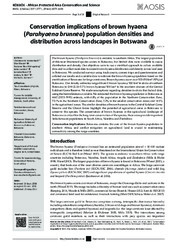Conservation implications of brown hyaena (Parahyaena brunnea) population densities and distribution across landscapes in Botswana.
Date
2017-08-16Author
Rich, Lindsey N.
Winterbach, Christiaan W.
Maude, Glyn
Klein, Rebecca
Mahupeleng, Gosiame Neo
Boast, Lorraine
Somers, Michael J.
Metadata
Show full item recordAbstract
The brown hyaena (Parahyaena brunnea) is endemic to southern Africa. The largest population of this near-threatened species occurs in Botswana, but limited data were available to assess distribution and density. Our objectives were to use a stratified approach to collate available data and to collect more data to assess brown hyaena distribution and density across land uses in Botswana. We conducted surveys using track counts, camera traps and questionnaires and collated our results and available data to estimate the brown hyaena population based on the stratification of Botswana for large carnivores. Brown hyaenas occur over 533 050 km² (92%) of Botswana. Our density estimates ranged from 0 brown hyaenas/100 km² in strata of northern Botswana to 2.94 (2.16–3.71) brown hyaenas/100 km² in the southern stratum of the Central Kalahari Game Reserve. We made assumptions regarding densities in strata that lacked data, using the best references available. We estimated the brown hyaena population in Botswana as 4642 (3133–5993) animals, with 6.8% of the population in the Northern Conservation Zone, 73.1% in the Southern Conservation Zone, 2.0% in the smaller conservation zones and 18.1%in the agricultural zones. The similar densities of brown hyaenas in the Central Kalahari Game Reserve and the Ghanzi farms highlight the potential of agricultural areas in Botswana to conserve this species. The conservation of brown hyaenas in the agricultural landscape of Botswana is critical for the long-term conservation of the species; these areas provide important links between populations in South Africa, Namibia and Zimbabwe.
Collections
- Research articles [88]

